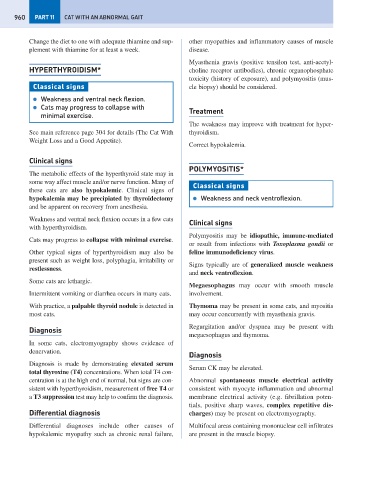Page 968 - Problem-Based Feline Medicine
P. 968
960 PART 11 CAT WITH AN ABNORMAL GAIT
Change the diet to one with adequate thiamine and sup- other myopathies and inflammatory causes of muscle
plement with thiamine for at least a week. disease.
Myasthenia gravis (positive tensilon test, anti-acetyl-
HYPERTHYROIDISM* choline receptor antibodies), chronic organophosphate
toxicity (history of exposure), and polymyositis (mus-
Classical signs cle biopsy) should be considered.
● Weakness and ventral neck flexion.
● Cats may progress to collapse with Treatment
minimal exercise.
The weakness may improve with treatment for hyper-
See main reference page 304 for details (The Cat With thyroidism.
Weight Loss and a Good Appetite).
Correct hypokalemia.
Clinical signs
POLYMYOSITIS*
The metabolic effects of the hyperthyroid state may in
some way affect muscle and/or nerve function. Many of
Classical signs
these cats are also hypokalemic. Clinical signs of
hypokalemia may be precipiated by thyroidectomy ● Weakness and neck ventroflexion.
and be apparent on recovery from anesthesia.
Weakness and ventral neck flexion occurs in a few cats
Clinical signs
with hyperthyroidism.
Polymyositis may be idiopathic, immune-mediated
Cats may progress to collapse with minimal exercise.
or result from infections with Toxoplasma gondii or
Other typical signs of hyperthyroidism may also be feline immunodeficiency virus.
present such as weight loss, polyphagia, irritability or
Signs typically are of generalized muscle weakness
restlessness.
and neck ventroflexion.
Some cats are lethargic.
Megaesophagus may occur with smooth muscle
Intermittent vomiting or diarrhea occurs in many cats. involvement.
With practice, a palpable thyroid nodule is detected in Thymoma may be present in some cats, and myositis
most cats. may occur concurrently with myasthenia gravis.
Regurgitation and/or dyspnea may be present with
Diagnosis
megaesophagus and thymoma.
In some cats, electromyography shows evidence of
denervation.
Diagnosis
Diagnosis is made by demonstrating elevated serum
Serum CK may be elevated.
total thyroxine (T4) concentrations. When total T4 con-
centration is at the high end of normal, but signs are con- Abnormal spontaneous muscle electrical activity
sistent with hyperthyroidism, measurement of free T4 or consistent with myocyte inflammation and abnormal
a T3 suppression test may help to confirm the diagnosis. membrane electrical activity (e.g. fibrillation poten-
tials, positive sharp waves, complex repetitive dis-
Differential diagnosis charges) may be present on electromyography.
Differential diagnoses include other causes of Multifocal areas containing mononuclear cell infiltrates
hypokalemic myopathy such as chronic renal failure, are present in the muscle biopsy.

